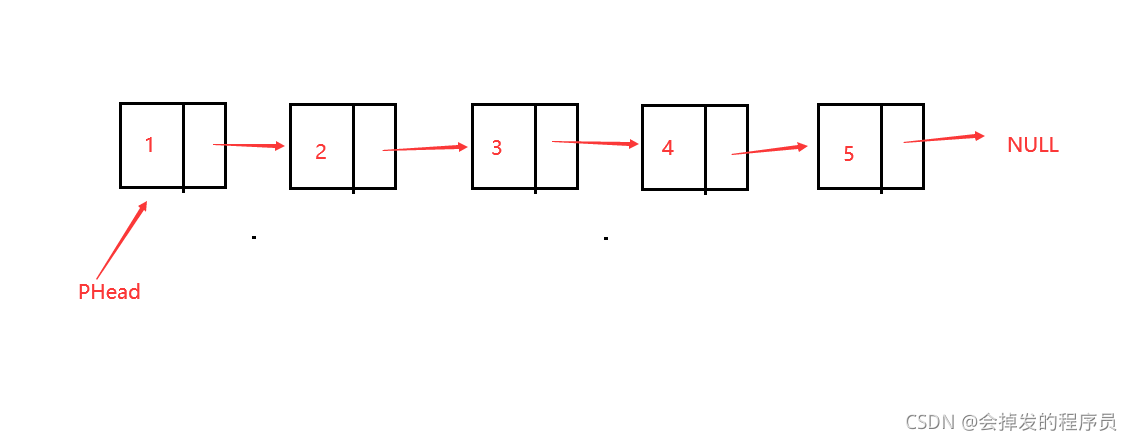您好,登錄后才能下訂單哦!
您好,登錄后才能下訂單哦!
這篇文章將為大家詳細講解有關C語言鏈表有什么用,小編覺得挺實用的,因此分享給大家做個參考,希望大家閱讀完這篇文章后可以有所收獲。
鏈表是一種物理存儲結構上非連續、非順序的存儲結構,數據元素的邏輯順序是通過鏈表中的指針鏈接次序實現的 。
代碼
struct Slist
{
int* a;
struct Slist* next;
};邏輯結構:

物理結構:

注意:
從上圖可以看出,鏈式結構在邏輯上是連續的,但是在物理上是不一定是連續的。
這些結點一般是從堆上申請出來的。
從堆上申請的空間,是按照一定的策劃來分配的,兩次申請的空間可能連續,大概率是不連續的。
實際中鏈表的結構非常多樣,以下情況組合起來就有8種鏈表結構:
1. 單向或者雙向
①單向

②雙向

2.帶頭或者不帶頭
①帶頭

②不帶頭

3.循環或者非循環
①循環

②非循環

雖然有這么多種結構的鏈表,但是我們實際中最常用的只有兩種結構:
1. 無頭單向非循環鏈表

2.帶頭雙向循環鏈表

1. 無頭單向非循環鏈表:結構簡單,一般不會單獨用來存數據。實際中更多是作為其他數據結構的子結構,如哈希桶、圖的鄰接表等等。另外這種結構在筆試面試中出現很多。
2. 帶頭雙向循環鏈表:結構最復雜,一般用在單獨存儲數據。實際中使用的鏈表數據結構,都是帶頭雙向循環鏈表。另外這個結構雖然結構復雜,但是使用代碼實現以后會發現結構會帶來很多優勢,實現反而簡單了,后面我們代碼實現了就知道了。
單鏈表結構
typedef int SLTDateType;
typedef struct SListNode
{
SLTDateType data;
struct SListNode* next;
}SListNode;單鏈表需要的功能
// 動態申請一個節點 SListNode* BuySListNode(SLTDateType x); // 單鏈表打印 void SListPrint(SListNode* plist); // 單鏈表尾插 void SListPushBack(SListNode** pplist, SLTDateType x); // 單鏈表的頭插 void SListPushFront(SListNode** pplist, SLTDateType x); // 單鏈表的尾刪 void SListPopBack(SListNode** pplist); // 單鏈表頭刪 void SListPopFront(SListNode** pplist); // 單鏈表查找 SListNode* SListFind(SListNode* plist, SLTDateType x); // 單鏈表在pos位置之后插入x // 分析思考為什么不在pos位置之前插入? void SListInsertAfter(SListNode* pos, SLTDateType x); // 單鏈表刪除pos位置之后的值 // 分析思考為什么不刪除pos位置? void SListEraseAfter(SListNode* pos); // 單鏈表的銷毀 void SListDestory(SListNode** pplist);
功能實現
SListNode* BuySListNode(SLTDateType x)
{
SListNode* newnode = (SListNode*)malloc(sizeof(SListNode));
if (newnode == NULL)
{
exit(-1);
}
newnode->data = x;
return newnode;
}
void SListPrint(SListNode* plist)
{
if (plist == NULL)
{
printf("NULL\n");
return;
}
else
{
while (plist)
{
printf("%d->", plist->data);
plist = plist->next;
}
printf("NULL\n");
}
}
void SListPushBack(SListNode** pplist, SLTDateType x)
{
SListNode* tail = *pplist;
SListNode* newnode = BuySListNode(x);
newnode->next = NULL;
if (tail == NULL)
{
*pplist = newnode;
}
else
{
while (tail->next)
{
tail = tail->next;
}
tail->next = newnode;
}
}
void SListPushFront(SListNode** pplist, SLTDateType x)
{
SListNode* newnode = BuySListNode(x);
newnode->next = *pplist;
*pplist = newnode;
}
void SListPopBack(SListNode** pplist)
{
assert(*pplist);
SListNode* tail = *pplist;
SListNode* Pretail = NULL;
if (tail->next == NULL)
{
*pplist = NULL;
return;
}
else
{
while (tail->next)
{
Pretail = tail;
tail = tail->next;
}
free(tail);
tail = NULL;
Pretail->next = NULL;
}
}
void SListPopFront(SListNode** pplist)
{
assert(*pplist);
SListNode* front = *pplist;
*pplist = front->next;
free(front);
front = NULL;
}
SListNode* SListFind(SListNode* plist, SLTDateType x)
{
assert(plist);
SListNode* pos = plist;
while (pos && pos->data != x)
{
pos = pos->next;
}
return pos;
}
void SListInsertAfter(SListNode* pos, SLTDateType x)
{
assert(pos);
SListNode* newnode = BuySListNode(x);
newnode->next = pos->next;
pos->next = newnode;
}
void SListEraseAfter(SListNode* pos)
{
assert(pos);
assert(pos->next);
SListNode* node = pos->next;
pos->next = node->next;
free(node);
}
void SListDestory(SListNode** pplist)
{
SListNode* node = *pplist;
SListNode* PreNode = NULL;
while (node)
{
PreNode = node->next;
free(node);
node = PreNode;
}
}雙向鏈表的結構
SListNode* BuySListNode(SLTDateType x)
{
SListNode* newnode = (SListNode*)malloc(sizeof(SListNode));
if (newnode == NULL)
{
exit(-1);
}
newnode->data = x;
return newnode;
}
void SListPrint(SListNode* plist)
{
if (plist == NULL)
{
printf("NULL\n");
return;
}
else
{
while (plist)
{
printf("%d->", plist->data);
plist = plist->next;
}
printf("NULL\n");
}
}
void SListPushBack(SListNode** pplist, SLTDateType x)
{
SListNode* tail = *pplist;
SListNode* newnode = BuySListNode(x);
newnode->next = NULL;
if (tail == NULL)
{
*pplist = newnode;
}
else
{
while (tail->next)
{
tail = tail->next;
}
tail->next = newnode;
}
}
void SListPushFront(SListNode** pplist, SLTDateType x)
{
SListNode* newnode = BuySListNode(x);
newnode->next = *pplist;
*pplist = newnode;
}
void SListPopBack(SListNode** pplist)
{
assert(*pplist);
SListNode* tail = *pplist;
SListNode* Pretail = NULL;
if (tail->next == NULL)
{
*pplist = NULL;
return;
}
else
{
while (tail->next)
{
Pretail = tail;
tail = tail->next;
}
free(tail);
tail = NULL;
Pretail->next = NULL;
}
}
void SListPopFront(SListNode** pplist)
{
assert(*pplist);
SListNode* front = *pplist;
*pplist = front->next;
free(front);
front = NULL;
}
SListNode* SListFind(SListNode* plist, SLTDateType x)
{
assert(plist);
SListNode* pos = plist;
while (pos && pos->data != x)
{
pos = pos->next;
}
return pos;
}
void SListInsertAfter(SListNode* pos, SLTDateType x)
{
assert(pos);
SListNode* newnode = BuySListNode(x);
newnode->next = pos->next;
pos->next = newnode;
}
void SListEraseAfter(SListNode* pos)
{
assert(pos);
assert(pos->next);
SListNode* node = pos->next;
pos->next = node->next;
free(node);
}
void SListDestory(SListNode** pplist)
{
SListNode* node = *pplist;
SListNode* PreNode = NULL;
while (node)
{
PreNode = node->next;
free(node);
node = PreNode;
}
}雙向鏈表的功能
//創建鏈表返回頭結點 LTNode* ListInit(); // 雙向鏈表銷毀 void ListDestory(LTNode* phead); // 雙向鏈表打印 void ListPrint(LTNode* phead); // 雙向鏈表尾插 void ListPushBack(LTNode* phead, LTDateType x); // 雙向鏈表尾刪 void ListPopBack(LTNode* phead); // 雙向鏈表頭插 void ListPushFront(LTNode* phead, LTDateType x); // 雙向鏈表頭刪 void ListPopFront(LTNode* phead); // 雙向鏈表查找 LTNode* ListFind(LTNode* phead, LTDateType x); // 雙向鏈表在pos的前面進行插入 void ListInsert(LTNode* pos, LTDateType x); // 雙向鏈表刪除pos位置的節點 void ListErase(LTNode* pos);
功能實現
LTNode* ListInit()
{
//哨兵位頭結點
LTNode* phead = (LTNode*)malloc(sizeof(LTNode));
if (phead == NULL)
{
printf("開辟空間失敗!!!\n");
exit(-1);
}
phead->next = phead;
phead->prev = phead;
return phead;
}
void ListDestory(LTNode* phead)
{
assert(phead);
LTNode* cur = phead;
LTNode* p = NULL;
LTNode* tail = phead->prev;
while (cur != tail)
{
p = cur;
cur = cur->next;
free(p);
}
free(tail);
}
void ListPrint(LTNode* phead)
{
assert(phead);
LTNode* front = phead->next;
while (front != phead)
{
printf("%d ", front->data);
front = front->next;
}
printf("\n");
}
void ListPushBack(LTNode* phead, LTDateType x)
{
assert(phead);
LTNode* tail = phead->prev;
LTNode* newnode = (LTNode*)malloc(sizeof(LTNode));
if (newnode == NULL)
{
printf("開辟空間失敗!!\n");
exit(-1);
}
newnode->data = x;
tail->next = newnode;
newnode->prev = tail;
newnode->next = phead;
phead->prev = newnode;
}
void ListPopBack(LTNode* phead)
{
assert(phead);
assert(phead != phead->next);
LTNode* tail = phead->prev;
LTNode* TailFront = tail->prev;
TailFront->next = phead;
phead->prev = TailFront;
free(tail);
}
void ListPushFront(LTNode* phead, LTDateType x)
{
assert(phead);
LTNode* next = phead->next;
LTNode* newnode = (LTNode*)malloc(sizeof(LTNode));
if (newnode == NULL)
{
printf("開辟空間失敗!!\n");
exit(-1);
}
newnode->data = x;
phead->next = newnode;
newnode->prev = phead;
newnode->next = next;
next->prev = newnode;
}
void ListPopFront(LTNode* phead)
{
assert(phead);
assert(phead != phead->next);
LTNode* head = phead->next;//頭結點
phead->next = head->next;
head->next->prev = phead;
free(head);
}
LTNode* ListFind(LTNode* phead, LTDateType x)
{
assert(phead);
LTNode* cur = phead->next;
while (cur != phead)
{
if (cur->data == x)
{
return cur;
}
cur = cur->next;
}
return NULL;
}
void ListInsert(LTNode* pos, LTDateType x)
{
assert(pos);
LTNode* posPrev = pos->prev;
LTNode* newnode = (LTNode*)malloc(sizeof(LTNode));
if (newnode == NULL)
{
printf("開辟空間失敗!!\n");
exit(-1);
}
newnode->data = x;
posPrev->next = newnode;
newnode->prev = posPrev;
newnode->next = pos;
pos->prev = newnode;
}
void ListErase(LTNode* pos)
{
assert(pos);
LTNode* posPrev = pos->prev;
LTNode* posNext = pos->next;
posPrev->next = posNext;
posNext->prev = posPrev;
free(pos);
}關于“C語言鏈表有什么用”這篇文章就分享到這里了,希望以上內容可以對大家有一定的幫助,使各位可以學到更多知識,如果覺得文章不錯,請把它分享出去讓更多的人看到。
免責聲明:本站發布的內容(圖片、視頻和文字)以原創、轉載和分享為主,文章觀點不代表本網站立場,如果涉及侵權請聯系站長郵箱:is@yisu.com進行舉報,并提供相關證據,一經查實,將立刻刪除涉嫌侵權內容。